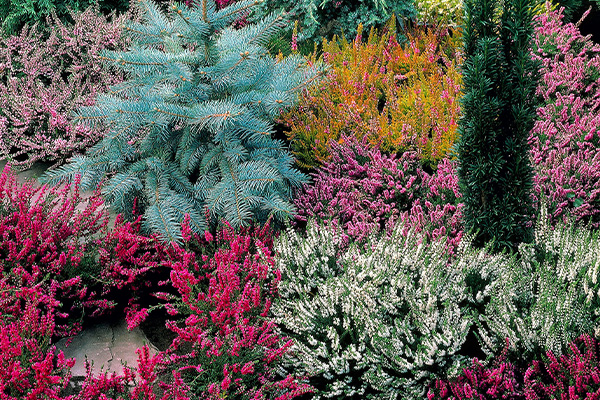How to Plant & Grow
Heathers
Heathers are short and compact evergreen shrubs that offer a wide selection of choices and colours! With some even being scented, growing a gorgeous seasonal display is easy with these attractive shrubs.
If you’re new to growing these heathers, then here are a few tips and tricks to keep them looking fabulous all season long.

What We've Included
Choosing Heather | When to Plant | Where to Plant | How to Plant | Feeding Heather | When to Water | Pruning | Propagating | Common Issues & How to Solve Them | When do they Flower? | Heather FAQs | Inspiration
Choosing the Best Heather for Your Garden
Several varieties make up the overall ‘heather’ umbrella. There’s Erica, Calluna, and Daboecia, all of which flower at different times of the year. This might differ slightly from plant to plant, but as a general rule:
Erica: Winter to spring.
Calluna: Summer to autumn.
Daboecia: Spring, summer, or autumn (depending on the variety).
If you’re looking for a summer display, then Calluna's are your ideal choice. And similarly, if you’re after a hardy display for the winter garden, then Erica’s are your best bet. Daboecia can flower any time of year, but this depends on the variety.
When to Plant Heathers
Heathers are best planted in spring or autumn, depending on the variety. You’re more likely to find winter-flowering heathers from autumn as winter bedding, and heathers for spring/summer flowers can be found in spring.

Where to Plant Heathers
Heathers love well-drained, acidic soil (some can thrive in neutral or alkaline soil). Ensure they’re planted somewhere sunny, as they love sunlight. A lightly shaded spot can also be tolerated.
How to Plant Heathers
Heathers are usually supplied in modules and pots, which are incredibly easy to plant and maintain.
Before planting heathers, it’s recommended to test your soil. Many varieties of heather prefer acidic soil (pH 5.5 or less), so use a test kit to double-check. You can add any ericaceous compost or well-rotted manure to the planting site to add acidity, working it in before planting.
- Dig a hole in the border that’s big enough to house the entire module. If planting in pots, fill a large pot halfway with potting soil and then make several holes that can hold the modules. Do this until the top of the soil from the module is just below the top of the pot.
- Fill around the modules with soil and firm them down gently.
- Water well and you’re done!
Feeding Heathers
Heathers grown in acidic soil won’t need feeding usually. But, if their foliage turns yellow, it could be a sign that the soil has become too alkaline. You can add an ericaceous fertiliser in late March to early April if this is the case.
Heathers grown in containers will have plenty of fertiliser in the first few months. After that, you can apply an ericaceous fertiliser throughout their growing season.

When to Water Heathers
Water new heathers regularly for their first year. After their first year, they can be quite drought tolerant and won’t need additional watering (except for in extreme drought). However, container-grown heathers will dry out quickly so make sure to water them well regularly, especially in summer.
Pruning Heathers
To prune heathers, simply snip off faded stems once they’ve finished flowering. Tree varieties won’t need much pruning either – simply cut it back by two-thirds, needing only a light pruning here and thereafter. If it gets too unruly, it can be cut back hard with success.
Propagating Heathers
You can take semi-ripe cuttings of heathers in summer. To do so, remove non-flowering side shoots, taking lower leaves and potting them into compost. Cover this with a plastic bag to create a humid environment. Keep somewhere shady for 8-12 weeks, then transplant into individual pots.

Common Issues & How to Solve Them
Heathers are quite hardy and won’t run into much trouble. However, they can be victim to phytophthora root rot, which is a fungus that causes the stem and roots to decay. This is often caused by waterlogged soil, and you may notice dieback or yellowing.
Ensuring their soil is well-draining is the first step to avoiding this issue. However, if your heathers become affected, they should be lifted and destroyed. Replace the soil with fresh topsoil and make sure you avoid planting other shrubs in that area.
When do Heathers Flower?
Flowering times will vary based on what plant you buy! As we’ve mentioned above, there are different species of heather, each flowering at different times of the year. Ericas can flower in winter/spring, calluna will flower in summer/autumn, and daboecia in spring/summer/autumn.
Heather FAQs
Q: How do you revive dying Heather plants?
A: You can prevent unsightly heathers by trimming them annually, removing old flowers where needed. If their roots are allowed to dry out completely, this could lead to an early death. If there’s still some hope, you can dig up the heather and soak the roots in a bucket of water to help rejuvenate them, replanting them back in place after.
Q: Do slugs eat Heather plants?
A: Slugs don’t tend to be a problem for heathers, so you won’t need to protect them.
Q: Are Heathers perennial?
A: Most heathers are evergreen perennials. We recommend double checking your variety if you’re unsure.
Ready to Shop?
Find some inspiration for your garden
